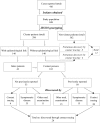Occupational risk of tuberculosis transmission in a low incidence area
- PMID: 15831092
- PMCID: PMC1087884
- DOI: 10.1186/1465-9921-6-35
Occupational risk of tuberculosis transmission in a low incidence area
Abstract
Background: To investigate the occupational risk of tuberculosis (TB) infection in a low-incidence setting, data from a prospective study of patients with culture-confirmed TB conducted in Hamburg, Germany, from 1997 to 2002 were evaluated.
Methods: M. tuberculosis isolates were genotyped by IS6110 RFLP analysis. Results of contact tracing and additional patient interviews were used for further epidemiological analyses.
Results: Out of 848 cases included in the cluster analysis, 286 (33.7%) were classified into 76 clusters comprising 2 to 39 patients. In total, two patients in the non-cluster and eight patients in the cluster group were health-care workers. Logistic regression analysis confirmed work in the health-care sector as the strongest predictor for clustering (OR 17.9). However, only two of the eight transmission links among the eight clusters involving health-care workers had been detected previously. Overall, conventional contact tracing performed before genotyping had identified only 26 (25.2%) of the 103 contact persons with the disease among the clustered cases whose transmission links were epidemiologically verified.
Conclusion: Recent transmission was found to be strongly associated with health-care work in a setting with low incidence of TB. Conventional contact tracing alone was shown to be insufficient to discover recent transmission chains. The data presented also indicate the need for establishing improved TB control strategies in health-care settings.
Figures
References
-
- Bradford WZ, Koehler J, El-Hajj H, Hopewell PC, Reingold AL, Agasino CB, Cave MD, Rane S, Yang Z, Crane CM, Small PM. Dissemination of Mycobacterium tuberculosis across the San Francisco Bay Area. J Infect Dis. 1988;177:1104–1107. - PubMed
-
- Gutierrez MC, Vincent V, Aubert D, Bizet J, Gaillot O, Lebrun L, Le Pendeven C, Le Pennec MP, Mathieu D, Offredo C, Pangon B, Pierre-Audigier C. Molecular fingerprinting of Mycobacterium tuberculosis and risk factors for tuberculosis transmission in Paris, France, and surrounding area. J Clin Microbiol. 1998;36:486–492. - PMC - PubMed
-
- Small PM, Hopewell PC, Singh SP, Paz A, Parsonnet J, Ruston DC, Schecter GF, Daley CL, Schoolnik GK. The epidemiology of tuberculosis in San Francisco. A population-based study using conventional and molecular methods. N Engl J Med. 1994;330:1703–1709. doi: 10.1056/NEJM199406163302402. - DOI - PubMed
Publication types
MeSH terms
LinkOut - more resources
Full Text Sources
Medical


